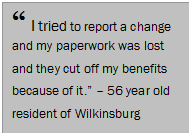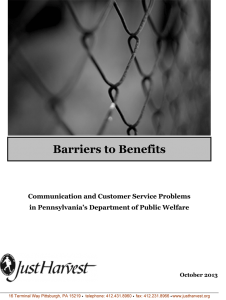Executive Summary
SNAP/food stamp applicants in Allegheny County frequently call Just Harvest for assistance with obtaining and maintaining benefits through the Department of Public Welfare (DPW). To gauge an understanding of the frequency of problems applicants face, two different approaches were taken to collect data: consumers of the SNAP program were surveyed about their experiences, and test calls were made to the publicized phone numbers of DPW’s Customer Help Lines and County Assistance Offices located within Allegheny County.
The results of these surveys and test calls illustrate that the department is failing to provide consumers with basic service at a level that is necessary for obtaining and maintaining benefits.
 Paperwork Problems Paperwork Problems
Nearly 30% of survey participants reported that they had an experience where the paperwork they provided was not processed in time for their benefits to continue uninterrupted. One in four reported that they experienced delays in changes taking effect – such as address changes or income changes. More than 1 in 5 reported experiencing a time where they were later told that paperwork they provided was not received.

Contacting Caseworkers
Clients have problems reached workers by phone. When using the Change Center – a statewide toll-free number that clients use to report changes in address or income – 40% of survey participants reported encountering hold times of an hour or longer, 66% had experienced high call volume disconnections, and 28% reported that these disconnections happened more often than not. The majority of surveyed consumers (63%) said that their caseworker never responded to tickets issued by the Change Center within the mandated three business day period.
When calling the local office, 82% of survey participants reported that they have experienced disconnections or full voicemails and 43% stated that is was more likely to be disconnected than to talk to someone. When they were able to leave a message, 48% reported never having their calls returned.
Test calls confirmed the high rate of automated messages, disconnections, and full voice mails. Half the time, callers heard a message about high call volumes, were directed to a full voicemail, or were given automated directions to another number – one that was just as likely to have the same problem.
These results show that the nature of these problems are not unique to an individual caseworker or office, nor are they phenomena related to unusual moments of peak call volume or crisis circumstances. They are widespread and systemic. The persistent inability of the CAO system to its workload – whether it be answering the phone, processing documents or returning voicemail messages – is a clear sign that the department is severely understaffed and lacks the basic resources necessary to enable community members to access vital public benefits.
 Read the full Barriers to Benefits report Read the full Barriers to Benefits report
|
 Since 2007, we have been helping eligible residents of Allegheny County to obtain food stamps from PA’s Department of Public Welfare (DPW). After years of hearing stories about their difficult experiences with the DPW, we realized these anecdotes required rigorous investigation.
Since 2007, we have been helping eligible residents of Allegheny County to obtain food stamps from PA’s Department of Public Welfare (DPW). After years of hearing stories about their difficult experiences with the DPW, we realized these anecdotes required rigorous investigation.![]() Barriers to Benefits: Communication and Customer Service Problems in Pennsylvania’s Department of Public Welfare and the campaign it inspired.
Barriers to Benefits: Communication and Customer Service Problems in Pennsylvania’s Department of Public Welfare and the campaign it inspired.




